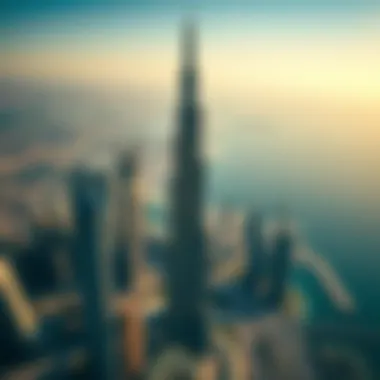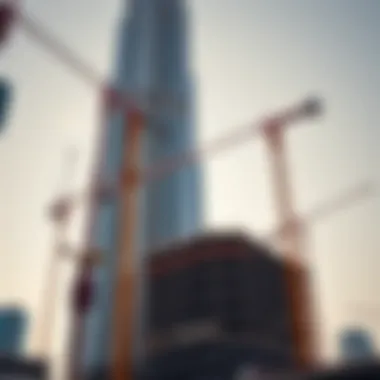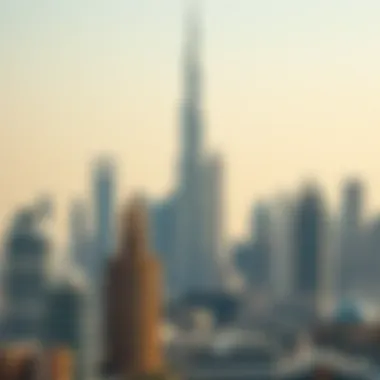Cost Analysis of Burj Khalifa: Understanding Its Financial Impact


Intro
The Burj Khalifa stands as a testament to architectural brilliance and ambition. Towering at 828 meters, it looms not just as the tallest building in the world but as a forebearer of Dubai's rapid expansion and economic strategy. Understanding the financial underpinnings of such a structure is crucial, especially considering how this colossal investment has reshaped the landscape of Dubai, both physically and economically. In this article, we will take a deep dive into the cost analysis of the Burj Khalifa, peeling back the layers to reveal the funding sources, construction costs, and the broader economic implications for the region.
This skyscraper is more than just an impressive edifice. It represents an incredible opportunity for investors and stakeholders wanting to navigate Dubai's ever-evolving real estate market. As we proceed, we will analyze not only the direct costs associated with this monumental project, but also its impact on property values within Dubai. We'll also look forward, considering the trends that investors should keep in mind when contemplating their next moves in this vibrant city.
In short, our exploration of the Burj Khalifa's costs will reveal not just numbers, but the story of a city's ambition and the opportunities it presents to astute investors and buyers alike. With that said, let us first examine the prevailing market trends that influenced this iconic construction.
Prelims to Burj Khalifa
The Burj Khalifa stands not just as the tallest building in the world but as a symbol of ambition, innovation, and the fierce drive for modernization that characterizes Dubai. Understanding Burj Khalifa's significance goes beyond mere numbers; it speaks volumes about the aspirations and potential of a city that emerged from the desert. In this section, we will delve into the historical context surrounding its construction, key features that set it apart, and its role in shaping Dubai's identity.
Historical Context and Significance
The Burj Khalifa's journey began in the early 2000s, rooted in a vision to create a global icon. At the turn of the millennium, Dubai was transforming itself from a modest trading post to a bustling metropolis aimed at attracting tourism, investments, and a myriad of global talents. The decision to construct this towering skyscraper was influenced by Dubai's desire to establish itself on the world stage, rivalling other major cities like New York and Tokyo.
In several ways, Burj Khalifa is a narrative of human achievement and architectural ingenuity. Completed in 2010, it not only broke the record for height but also set new benchmarks in engineering, allowing for unprecedented vertical living and working spaces. More than just a structure, the Burj Khalifa has become a national symbol, contributing to the pride of Emiratis and reflecting Dubai's progressive vision. Its mere silhouette evokes discussions about culture, heritage, and the fusion of both in contemporary times.
Key Features and Specifications
The Burj Khalifa stands at a staggering height of 828 meters. This architectural marvel consists of 163 floors, with the design carefully crafted to optimize structural integrity against wind pressures, which reach their peak at such heights. Key features worth noting include:
- Design Inspiration: Influenced by the Hymenocallis flower, the building's sleek and tapering form not only adds aesthetic appeal but enhances its stability.
- Materials Used: Around 103,000 square meters of glass, 15,500 square meters of embossed stainless steel, and structural elements like reinforced concrete are part of its complex makeup.
- Elevator Systems: The Burj boasts some of the world's fastest elevators, whisking visitors to dizzying heights in under a minute.
- Observation Deck: At the 148th floor, the observation deck offers breathtaking views of the Arabian Gulf and beyond, attracting millions of visitors annually.
Recognizing these features not only sheds light on the complexities of its construction but also hints at the substantial financial investments required to bring this vision to life. In turn, it sets the stage for further discussions on total construction costs and the implications of such figures in Dubai’s overall economic landscape.
"A defining characteristic of the Burj Khalifa is not just its impressive altitude, but its ability to evoke emotion—pushing the boundaries of what is architecturally feasible, inspiring future generations to aim higher."
In summary, the Burj Khalifa is testament to both modern engineering capabilities and the ambitious spirit of a city that refuses to be defined by its past. As we explore the financial aspects in the following sections, it's pivotal to keep the history and significance of this landmark in mind, for they form the bedrock of its extraordinary cost and ongoing impact.
Total Construction Cost Overview
Understanding the total construction cost of the Burj Khalifa is essential as it provides a comprehensive view of the financial landscape surrounding this monumental architectural endeavor. From the initial footprint on the drawing board to the towering presence above the Dubai skyline, every aspect of the construction reflects a layer of financial complexity. The myriad factors contributing to the overall expenditure lay bare the intricacies of mega-project management. Additionally, this analysis can aid investors and stakeholders in recognizing the balance of investment against future returns.
The significance of breaking down the costs allows for a clearer picture of how funds were allocated across various categories. By dissecting these financial components, one can appreciate the careful planning and execution that went into bringing this skyscraper to life. A thorough examination reveals not only the price tags of materials and labor but also the often-overlooked costs related to land acquisition. These insights are pivotal for anyone considering involvement in real estate investments in Dubai or similar markets.
Breakdown of Expenses
Materials


Materials account for a significant chunk of the total construction costs; their characteristics directly influence the durability and aesthetic appeal of the finished product. For Burj Khalifa, the selection of high-quality materials was pivotal. Items like reinforced concrete and glass were utilized on a grand scale, making this skyscraper not only a visual spectacle but also a strong structure.
One standout feature of these materials is their ability to withstand the harsh climate of the Middle East. The insulation properties of the glass were designed to reduce energy consumption significantly, an increasingly popular feature in modern construction. However, the high cost of premium materials can be a double-edged sword; while they ensure longevity and lower maintenance in the long run, they also inflate initial construction expenses.
Labor
Labor costs escalate rapidly on ambitious projects like Burj Khalifa. Employing skilled professionals in both construction and design sectors contributed to a substantial portion of the budget. The work involved not just manual labor but also a plethora of specialists, including engineers and architects who brought their expertise to various stages of the process. This diversity of skilled labor was necessary for maintaining high standards throughout the project's timeline.
However, labor costs do not just represent salaries; they encompass training and safety measures, especially when working at heights that would make heads spin. Investing in safety protocols is a hallmark of responsible construction practice but can add significantly to the budget. Achieving a balance between cost, skill level, and safety is always a challenge in such extensive projects.
Land Acquisition
When it comes to land acquisition, the location of Burj Khalifa was as crucial as the building itself. Situated in the heart of downtown Dubai, securing the land necessary for a skyscraper of such magnitude came at a premium price. The strategic location was chosen for its visibility and accessibility, ensuring maximum foot traffic and media exposure.
Additionally, negotiating for prime land often involves complex legal and financial maneuvers that can consume precious resources. One unique challenge in this case was aligning public interests with private development goals, a dance that frequently raises the ante in urban developments. Gaining the necessary permissions and working with various governmental layers added to the overall expenditure, highlighting the often unseen costs of bringing a project from conception to reality.
Final Cost of Burj Khalifa
The final cost of the Burj Khalifa, which rounds off all the aforementioned expenses, ultimately reflects the grandeur of the project. With the total construction cost assessed at approximately $1.5 billion, this figure illustrates just how much investment was poured into crafting not just a building, but an icon. For investors, understanding this scale is crucial, as it signifies the level of commitment bureaucracy and funding demands in comparable projects.
Funding Sources for Burj Khalifa
Understanding the funding sources for the Burj Khalifa is crucial to grasping how such a colossal project came to fruition. The financial backing behind this architectural wonder goes beyond mere numbers; it reflects the vision and ambition of a city looking to place itself on the global map. Not only does it explore the investments made, but it also sheds light on the economic strategies intertwining both public and private sectors. Investors and real estate enthusiasts alike would find this discussion particularly relevant as it provides insight into what it takes to fund colossal undertakings and the associated risks and rewards.
Public versus Private Investments
When we talk about public versus private investments in the context of the Burj Khalifa, it’s like comparing apples and oranges, albeit both contribute significantly to the overall funding. Public investments usually come from government resources or projects backed by tax revenues, while private investments are rooted in the financial markets, firms, and individuals.
- Public Investments: The Dubai government played a pivotal role in funding the Burj Khalifa. Investments from the government can pave the way for large-scale projects through subsidies, grants, and even direct funding.
- Private Investments: Emaar Properties, a real estate giant in the UAE, took the reins as the main developer, bringing in a hefty amount of private capital. This private funding sorely demonstrates the trust investors had in Emaar’s vision and the potential profitability of the project.
The balance between these two types of funding is what ultimately allowed for such extensive development. It sets a foundation that navigates between public welfare and private profit—an intricate dance that many developers face in global cities. Having both these funding streams mitigates risks while maximizing opportunities to attract more investors.
Role of Emaar Properties
Emaar Properties stands as a cornerstone in the grand scheme of Burj Khalifa's funding. Established as a vital player in not just the construction of the skyscraper but in Dubai’s overall property market, the firm is a narrative in itself of opportunity meets ambition.
Emaar's influence transitioned Burj Khalifa from a mere blueprint to an iconic structure through a few critical actions:
- Management Expertise: Emaar brought with it the know-how of executing large-scale developments efficiently. Their invigorating management strategies ensured that costs were maintained without compromising quality.
- Brand Value: By attaching its brand to the Burj Khalifa, Emaar didn’t just create a structure; it created a lifestyle brand. It set the precedent for luxury living, bolstered by the appeal of residing in the tallest building in the world.
- Market Expansion: The firm’s role transcended funding; it planted the seeds for future investments, sparking a ripple effect in the local economy. Emaar’s success led to an influx of business ventures and tourism that continue to reshape Dubai’s economic landscape.


In summary, Emaar Properties proved to be more than just a developer; it was a strategic partner that interlaced public funding and private investment into a tapestry of ingenuity. Understanding these dynamics offers crucial reflections for any investor looking to set their sights on high-stakes urban ventures.
Comparative Analysis with Other Global Landmarks
A comparative analysis of the Burj Khalifa with other notable skyscrapers worldwide serves several pivotal roles in understanding its financial and architectural significance. This section peels back the layers of how such structures contribute not only to their immediate surroundings but also to the global skyline and economy. By drawing parallels with other landmarks, we can identify trends, investment patterns, and economic implications gleaned from past ventures, thus equipping potential investors and analysts with vital insights.
Financial Overview of the Taipei
When we cast our gaze upon Taipei 101, it becomes evident that this towering structure, once the tallest in the world, represents a benchmark against which many skyscrapers are measured. Completed in 2004, Taipei 101 had an estimated construction cost of around $1.8 billion, a significant figure that incorporated state-of-the-art technologies and seismic protections. The financial outlay for Taipei 101 was driven by a strong emphasis on functionality and safety in a region prone to earthquakes.
This skyscraper is more than just a feat of engineering; it’s a symbol of Taiwan's economic aspirations. The building is designed to be energy-efficient, utilizing features such as double-pane glass and an innovative ventilation system. Investing in such advanced technologies demonstrates a commitment to sustainability. Not only has Taipei 101 inspired many future projects, but its operational financial model showcases a significant return on investment from tourism and retail, evidenced by its blend of observation decks and commercial space.
"Taipei 101 isn't just an architectural marvel; it's a manifestation of Taiwan's rugged determination and economic resilience."
Cost Comparison with One World Trade Center
On the other side of the globe, One World Trade Center rises as a phoenix from the ashes of tragedy, symbolizing resilience and renewal. The estimated cost for this impressive structure was around $3.9 billion, making it one of the most expensive buildings ever constructed. Its hefty price tag reflects the high-level security features integrated into its design, a necessity post-9/11, as well as the logistical challenges posed by its location in New York City.
In terms of financing, One World Trade Center utilized a mix of public and private funding, a model that mirrors the collaborative approach seen with the Burj Khalifa. The comparison highlights the growing trend of leveraging mixed financing models to realize monumental projects. Additionally, while the Burj Khalifa's initial economic impact was immediate due to its prominence in Dubai's tourism sector, One World Trade Center serves as a pivotal business hub, contributing to the revitalization of the Financial District.
Evaluating both structures helps underline the different financial strategies that underpin towering ambitions. Metro areas leveraging skyscrapers for tourism, like Dubai and New York, demonstrate differing economic benefits that extend far beyond their construction costs.
Economic Impact on Dubai
Understanding the economic impact of the Burj Khalifa goes beyond its title as the tallest structure in the world. This skyscraper is an emblem of Dubai's ambitions and its rapid development in a relatively short span. The construction and continued operation of the Burj Khalifa have triggered substantial economic benefits, influencing various sectors such as tourism and real estate. For investors and real estate professionals, considering these effects is crucial for assessing future opportunities and the sustainability of investments in this vibrant city.
Tourism Revenue from Burj Khalifa
The Burj Khalifa attracts millions of visitors each year, serving as a key driver of tourism in Dubai. The observation deck alone, found on the 148th floor, offers a breathtaking panorama that draws in crowds from every corner of the globe.
- Impact on Tourism Revenue: The presence of the Burj Khalifa elevates Dubai's status as a top travel destination. According to local tourism statistics, the tower is often listed as one of the top attractions globally. The revenue generated from ticket sales contributes significantly to the city's economy, enhancing the local hospitality sector.
- Multiplier Effect: Increased foot traffic translates into higher spending at nearby hotels, restaurants, and retail establishments. The tower has spurred the development of upscale shopping experiences and fine dining options, creating a ripple effect beneficial for local businesses.
"The Burj Khalifa is not just a building; it's a magnet for tourists and investors alike, reshaping the landscape of Dubai's economy."
- Cultural Symbolism: Moreover, the Burj Khalifa symbolizes the ambitious spirit of the city, attracting tourists interested not only in the building itself but also in its architectural significance and modernity. Events held at the tower, such as New Year’s Eve fireworks, further extend this appeal, attracting thousands of visitors and boosting the city’s international profile.
Real Estate Market Dynamics
The presence of the Burj Khalifa has dramatically influenced the real estate market in Dubai. Properties located near this iconic skyscraper have seen boosted value over the years, appealing to both local and international buyers.


- Increased Property Valuation: Skyscrapers tend to mark urban centers; the Burj Khalifa is no exception. Properties within its vicinity often warrant high asking prices. Investors see potential in real estate surrounding the monument, leading to escalating property values in the neighborhood.
- Luxury Living: With high-end developments in the area, there is a demand for luxury living. This phenomenon has resulted in a significant increase in the availability of high-rise apartments and penthouses, attracting affluent expats and investors. The allure of living close to such a prestigious address drives interest and investment.
- Resilience in Market: Even during economic downturns, the properties near Burj Khalifa often retain their value better than others in the market. The area's prestige and continuous demand contribute to its resilience, making it an attractive proposition for investors seeking stable returns.
In summary, the Burj Khalifa significantly impacts both tourism and real estate dynamics in Dubai. For serious investors and industry analysts, understanding these economic implications is essential in navigating and forecasting future trends in one of the world’s most rapidly evolving markets.
Future Investments and Developments
The Burj Khalifa stands as a beacon of architectural excellence and symbolizes Dubai’s vision for a prosperous future. As the city continues to evolve, the importance of future investments and developments cannot be overstated. Investors, developers, and city planners are eager to grasp the implications of this iconic structure, and understanding future trends is crucial for securing success in a dynamic landscape.
Sustainability in Future Projects
Sustainability has become a paramount consideration in modern architecture, and Burj Khalifa serves as a learning resource. Future projects inspired by this landmark must prioritize eco-friendly practices. This doesn't only address environmental concerns but also reflects an ongoing commitment to economic resilience.
- Resource Efficiency: Emphasizing low-energy materials and innovative construction techniques can reduce both costs and the carbon footprint. For instance, incorporating solar panels or rainwater harvesting systems can markedly enhance the sustainability quotient.
- Green Spaces: Integrating parks and communal areas within future projects can improve community health and wellbeing. Just as Burj Khalifa incorporated a lush landscape at its base, future developments can benefit from greenery that encourages outdoor activity.
- Smart Technologies: The implementation of smart building technologies, such as energy-efficient HVAC systems or smart grids, can significantly improve operational efficiency, making buildings not just livable but also consciously integrated with their environment.
Shaping future projects with sustainability in mind isn’t just a trend; it’s a necessity that will attract conscientious investors and residents alike.
Potential for Future Landmarks
As Dubai continues to grow, there’s an immense potential for new landmarks that echo the grandeur of Burj Khalifa. Each new project not only contributes to the skyline but also offers various investment opportunities.
- Cultural Institutions: Projects like museums or cultural centers are expected to draw international tourists and provide a platform for local artists. The emphasis on culture can diversify Dubai’s appeal, enhancing its reputation as a global hub.
- Mixed-Use Developments: With the rise of urban living, mixed-use spaces that incorporate residential, retail, and business facilities are becoming desirable. These developments can create vibrant neighborhoods that cater to diverse lifestyles, offering a plethora of amenities around the clock.
- Sustainable Transportation Hubs: As the city expands, efficient transportation infrastructure becomes critical. Projects like high-speed rail systems or an extensive metro network will not only ease mobility but can also drive real estate value in surrounding areas.
"Dubai is not just a city; it’s a canvas for the future where every investment can become part of a larger masterpiece.”
For more in-depth insights, visit Emaar Properties, the leading real estate development company behind Burj Khalifa.
Finale
The financial implications of the Burj Khalifa stretch far beyond its sheer height and iconic status. Understanding these implications is not just academic; it's a vital exercise for current and potential stakeholders within the real estate market. The cost analysis presented throughout this article serves as a critical lens to appreciate not only the financial heft of such a towering endeavor but also the multifaceted benefits it can bring to a rapidly developing city like Dubai.
Summarizing the Financial Insights
To summarize, the financial aspects of constructing the Burj Khalifa highlight several key insights:
- Total Construction Cost: The price tag of over $1.5 billion encapsulates various expenditures including labor, materials, and land acquisition.
- Funding Sources: A mix of public and private investments facilitated the project, reflecting a strong commitment from Emaar Properties, a major player in the region's real estate landscape.
- Economic Impact: Beyond direct construction costs, the skyscraper has substantially boosted tourism and real estate sectors, becoming an emblematic feature of Dubai's skyline.
The narrative of the Burj Khalifa isn't just about a building; it's about strategic investments that have ripple effects on economic growth and urban development. Knowledge from such a detailed financial analysis equips investors and analysts with a more profound understanding of the real estate market cues generated by landmark constructions.
Implications for Future Investors
Looking towards the horizon, several implications stand out for future investors considering similar projects:
- Strategic Planning: Investors should take cues from the Burj Khalifa project about integrating sustainability and innovative design into future investments.
- Market Positioning: The prominence of the Burj Khalifa highlights the benefits of securing landmark status, a consideration vital for attracting tourism and elevating property values in related sectors.
- Potential Risks: While the financial insights seem optimistic, the volatility of market conditions necessitates thorough risk assessments and contingency planning.
The lessons drawn from the cost analysis of the Burj Khalifa establish a framework not simply for architectural ambition but for astute financial decision-making in one's ventures. As the landscape of investments continues to evolve, the principles gleaned from Dubai's tallest skyscraper may well serve as a compass for future projects.



